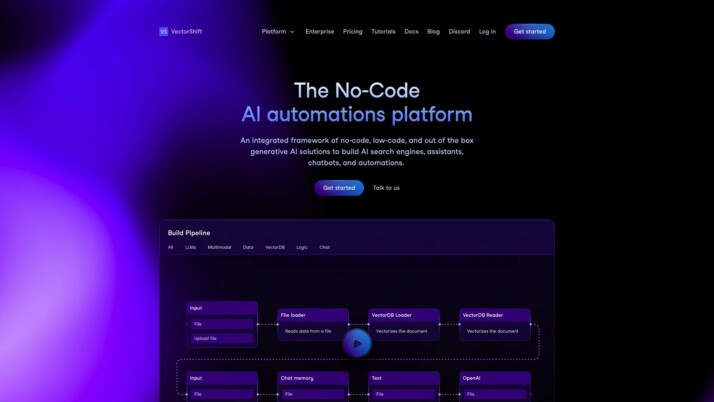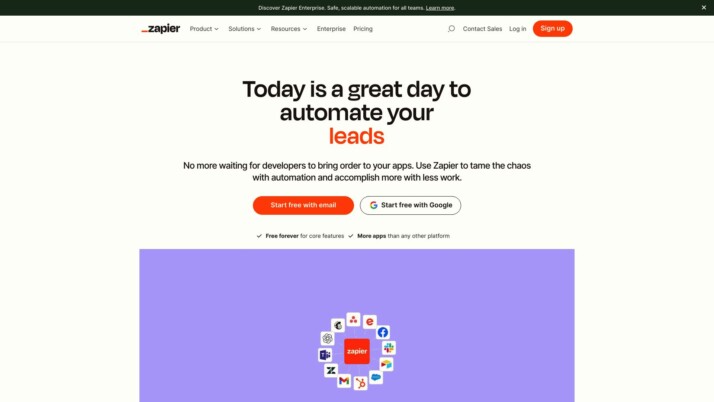VectorShift vs. Zapier: Which Automation Tool Suits Your Needs?
In the ever-evolving digital landscape, businesses and individuals alike are continuously seeking efficient solutions to streamline their workflows and harness the power of cutting-edge technologies. In this comprehensive comparison, we delve into two prominent platforms, VectorShift vs. Zapier, each offering unique capabilities and catering to distinct user needs. Whether you’re seeking to leverage AI for automation and content creation or integrate disparate applications for seamless data exchange, this review aims to provide valuable insights to help you make an informed decision.
VectorShift Overview
VectorShift is a comprehensive platform designed to empower users in creating, deploying, and managing generative AI workflows and automations. It caters to both technical and non-technical individuals through its dual interface approach, offering a no-code builder and a code SDK.


One of the standout features of VectorShift is its versatility in supporting a wide range of applications, including chatbots, search functionalities, automations, and content creation. This flexibility allows users to centralize and streamline various AI-driven tasks within a single platform.
VectorShift’s core functionality revolves around its pipeline dashboard, where users can create AI workflows from scratch or utilize pre-built templates. The deployment process is streamlined, allowing workflows to be implemented as chatbots, automations, or search functions, with various customization and export options available.
VectorShift seamlessly integrates with various data sources such as Google Drive, Slack, OneDrive, Airtable, and more, enabling centralized data management and live-syncing across applications.
One of the key strengths of VectorShift is its extensive integration capabilities. The platform seamlessly integrates with various data sources such as Google Drive, Slack, OneDrive, Airtable, and more, enabling centralized data management and live-syncing across applications. This centralization of data, coupled with VectorShift’s robust knowledge base and semantic search capabilities, enhances the accuracy and relevance of the AI’s responses.
Zapier Overview
Zapier is a leading online automation and integration platform that connects thousands of web applications, software-as-a-service tools, and APIs. Its core offering allows users to create automated workflows called Zaps that seamlessly move data between different apps and services.


With its vast library of pre-built integrations spanning over 6,000 apps, Zapier empowers businesses and individuals to streamline repetitive tasks and bridge the gaps between disparate software solutions. Whether it’s synchronizing customer data across multiple platforms, automating social media posting, or triggering notifications based on specific events, Zapier simplifies these processes through its intuitive, no-code visual workflow builder.
Zapier’s vision is to become the integration and automation backbone for small and medium-sized businesses, enabling them to leverage the power of seamless connectivity across the tools they rely on daily.
By continuously expanding its ecosystem and fostering partnerships with leading software companies, Zapier aims to make its workflows an integral part of standard business processes.
Feature Comparison
VectorShift and Zapier are distinctly different platforms, with VectorShift being an AI-centric workflow automation tool, while Zapier focuses more on integrating and automating data flows between various applications and services. VectorShift’s unique selling point lies in its ability to incorporate AI capabilities into its workflows, allowing users to leverage natural language processing, text generation, and other advanced AI functionalities. This makes VectorShift particularly well-suited for use cases that require intelligent decision-making, content creation, or conversational interfaces.
While Zapier does not natively support AI capabilities, it can potentially integrate with AI services through custom integrations or API connections.
On the other hand, Zapier excels at connecting and syncing data across a vast ecosystem of over 6,000 apps and services. Its strength lies in its simplicity and ease of use, enabling users to automate repetitive tasks and streamline data exchange between different tools without the need for complex coding.
Another key difference is the target audience. VectorShift appeals more to businesses and individuals seeking to leverage AI for automation, content creation, and data analysis. On the contrary, Zapier’s user base encompasses a broader range of small and medium-sized businesses looking to optimize their workflows across various software tools, regardless of their industry or specific use case.
| VectorShift | Zapier | SmythOS | |
|---|---|---|---|
| CORE FEATURES | |||
| Memory & Context | ✅ | ❌ | ✅ |
| Problem-Solving Capabilities | ✅ | ❌ | ✅ |
| Multimodal | ✅ | ❌ | ✅ |
| Human-AI Interaction | ✅ | ❌ | ✅ |
| Audit Logs for Analytics | ❌ | ✅ | ✅ |
| SECURITY | |||
| Data Encryption | ❌ | ✅ | ✅ |
| COMPONENTS | |||
| Foundation AIs | ✅ | ❌ | ✅ |
| Zapier APIs | ❌ | ✅ | ✅ |
| Logic | ✅ | ❌ | ✅ |
| DEPLOYMENT OPTIONS | |||
| Deploy as Site Chat | ✅ | ❌ | ✅ |
| Staging Domains | ❌ | ✅ | ✅ |
| Deploy as Scheduled Agent | ✅ | ❌ | ✅ |
| DATA LAKE SUPPORT | |||
| Hosted Vector Database | ✅ | ❌ | ✅ |
| TXT File Support | ✅ | ❌ | ✅ |
Conclusion
SmythOS stands as a versatile and comprehensive platform, empowering users to create, deploy, and manage AI agents with unparalleled ease and efficiency. With its no-code visual builder and extensive integration capabilities, SmythOS democratizes AI development, making it accessible to a wide range of users, from technical teams to business professionals.
One of the standout features of SmythOS is its ability to orchestrate multi-agent collaboration, allowing teams of AI agents to work together seamlessly on complex tasks.
This collaborative approach enhances scalability and problem-solving prowess, enabling businesses to tackle intricate challenges with greater efficiency.
Whether you’re a developer seeking to streamline AI workflows, an enterprise aiming to leverage cutting-edge AI capabilities, or a small business looking to automate processes, SmythOS offers a holistic solution tailored to your needs. With features like data encryption, OAuth support, and constrained alignment, SmythOS ensures that your AI implementations are secure and aligned with your unique requirements.
To unlock the full potential of SmythOS and explore its groundbreaking capabilities, visit our website at SmythOS. Discover our extensive library of agent templates, 300k+ integrations, and learn how you can deploy agents anywhere, from APIs and webhooks to chatbots and scheduled agents. Get inspired by customer reviews and explore our comprehensive documentation and pricing plans. Stay connected with us through our social media channels, including Twitter and LinkedIn, or join our vibrant community on Discord.
Last updated:
Disclaimer: The information presented in this article is for general informational purposes only and is provided as is. While we strive to keep the content up-to-date and accurate, we make no representations or warranties of any kind, express or implied, about the completeness, accuracy, reliability, suitability, or availability of the information contained in this article.
Any reliance you place on such information is strictly at your own risk. We reserve the right to make additions, deletions, or modifications to the contents of this article at any time without prior notice.
In no event will we be liable for any loss or damage including without limitation, indirect or consequential loss or damage, or any loss or damage whatsoever arising from loss of data, profits, or any other loss not specified herein arising out of, or in connection with, the use of this article.
Despite our best efforts, this article may contain oversights, errors, or omissions. If you notice any inaccuracies or have concerns about the content, please report them through our content feedback form. Your input helps us maintain the quality and reliability of our information.
